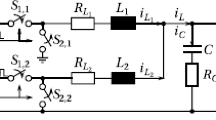Abstract
This paper presents the design, implementation, and testing of a proof-of-concept monolithic single-input dual-output buck converter. The proposed architecture implements an analog hysteretic controller. This avoids the use of extra circuitry to generate a dedicated reference carrier signal to create the pulse-width modulated waveform, thus saving area, and reducing static power consumption. Furthermore, the proposed topology implements only three switches (instead of four switches in conventional solutions), and can save additional silicon area with proper design of the power switches in the voltage regulator. The IC prototype was fabricated in standard 0.5 μm CMOS technology (VTHN = 0.78 V, VTHP = −0.93 V), operates with a single voltage supply of 1.8 V, generates 1.2 and 0.9 V output-voltage levels, and supplies a maximum total current of 200 mA (100 mA provided by each output), reaching up to 88 % efficiency.




















Similar content being viewed by others
References
Kursun, V. & Friedman, E. G. (2006). Multi-voltage CMOS circuit design. New York: Wiley.
Kumar, P., Rojas-González, M. (2006). Novel 3-switch dual output buck voltage regulator. 21st Annual IEEE Applied Power Electronics Conference (APEC), (pp. 467–473).
Kumar, P. (2009). Multiple output buck converter, US Patent 7511463.
Chakraborty, S., Jain, A. K. & Mohan, N. (2006). A novel converter topology for multiple individually regulated outputs. IEEE Transactions on Power Electronics 21(2), 361–369.
Chabini, N., Chabini, I., Aboulhamid, E. M. & Savaria, Y. (2003). Methods for minimizing dynamic power consumption in synchronous designs with multiple supply voltages. IEEE Transactions on Computer-Aided Design of Integrated Circuits and Systems 22(3), 346–351.
Chang , J. & Pedram, M. (1997). Energy minimization using multiple supply voltages. IEEE Transactions on Very Large Scale Integration (VLSI) Systems 5(4), 436–443.
Usami, K., Igarashi, M., Minami, F., Ishikawa, T., Kanzawa, M., Ichida, M. & Nogami, K. (1998). Automated low-power technique exploiting multiple supply voltages applied to a media processor. IEEE Journal of Solid-State Circuits 33(3), 463–472.
Dancy, A. P., Amirtharajah, R. & Chandrakasan, A. (2000). High-efficiency multiple-output DC–DC conversion for low-voltage systems. IEEE Transactions on Very Large Scale Integration (VLSI) Systems 8(3), 252–263.
Bonizzoni, E., Borghetti, F., Malcovati, P., Maloberti, F., Niessen, B. (2007). A 200 mA 93 % peak efficiency single-inductor dual-output DC–DC buck converter. IEEE International Solid-State Circuits Conference Digest of Technical Papers, pp. 526–527.
Erickson, R. W. & Maksimovic, D. (2001). Fundamentals of Power Electronics, 2nd edn. Norwell: Kluwer Academic Publishers.
Utkin, V., Guldner, J. & Shi, J. (1999). SSliding mode control in electromechanical systems. Philadelphia: Taylor and Francis Inc.
Rojas-González, M. A. & Sánchez-Sinencio, E. (2007). Design of a class D audio amplifier IC using sliding mode control and negative feedback. IEEE Transactions on Consumer Electronics, 53(2), 609–617.
Rojas-González, M. A. & Sánchez-Sinencio, E. (2009). Low-power high-efficiency class D audio power amplifiers. IEEE Journal of Solid-State Circuits, 44(12), 3272–3284.
Johns, D., Martin, K. (1997). Analog integrated circuit design. New York: Wiley.
Tan, S., Lai, Y.M., Cheung, M.K.H. & Tse, C.K. (2005). On the practical design of a sliding mode voltage controlled buck converter. IEEE Transaction on Power Electronics, 20(2), 425–437.
Abo, A. M. & Gray, P. R. (1999). A 1.5 V, 10-bit, 14.3-MS/s CMOS pipeline analog-to-digital converter. IEEE Jornal of Solid-State-Circuits, 34(5), 599–606.
Acknowledgements
The authors would like to thank the National Council on Science and Technology of Mexico (CONACYT) and Texas Instruments for partial funding support.
Author information
Authors and Affiliations
Corresponding author
Appendix 1 sliding mode controller
Appendix 1 sliding mode controller
In this appendix, the general form of the switching function in a SMC for asymptotic tracking is discussed [11]. The SMC can be derived if the system is expressed in its controllable canonical form
where ea is the error function, eρ is the control input, and ρ is the order of the system to be controlled. The control input in Eq. (13) is the linear combination of all state canonical state variables where its coefficients are chosen in such way that the polynomial expressed in Eq. (14) meets the Hurwitz criterion, i.e. all its roots have negative real part.
The switching function in Eq. (15) represents the (ρ − 1) dimensional surface where the points of discontinuity merge.
For the particular case of ρ = 2, Eq. (15) simply becomes Eqs. (5) and (6).
Rights and permissions
About this article
Cite this article
Rojas-González, M.A., Torres, J., Kumar, P. et al. Design of an integrated single-input dual-output 3-switch buck converter based on sliding mode control. Analog Integr Circ Sig Process 76, 307–319 (2013). https://doi.org/10.1007/s10470-013-0039-5
Received:
Revised:
Accepted:
Published:
Issue Date:
DOI: https://doi.org/10.1007/s10470-013-0039-5




